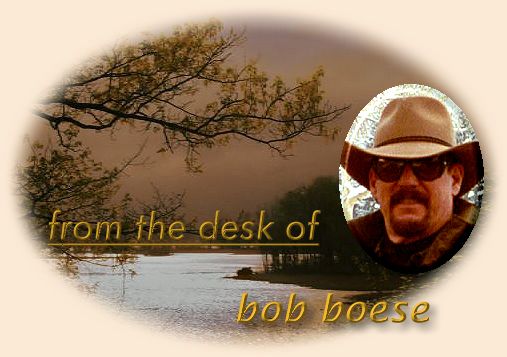|
[Generic flies are simple-to-tie patterns that a novice tyer can
accomplish and which requires less
than four dressing components.]
Okay, eavesdropping is a bad habit. But there I am with a
mouthful of biscuits and gravy when, wafting over the whoosh
of the 60s air conditioner, comes a fly fishing conversation.
Don't know the speaker, can't say if he knows a sculpin from
a BWO, or if his roll cast looks like coils of garden hose, but I
listen because he caught fish – which qualifies him as an
expert. At least he says he did, and eavesdroppers chronically
suspend reality to believe what they hear. So, like one of the fish
of his tales, I am hooked.
Sipping water to look inconspicuous, I lean toward him, silently
cursing other diners for clanking forks on their plates or having
the audacity to hold conversations while I'm trying to overhear
Mr. Caughtfish. In suspense filled tones he explains yesterday's
wind and weather conditions, which everyone listening already
knew, but he's the type that needs plenty of backdrop for his story.
Paddle stroke by paddle stroke he drags us through the cypress
trees until we reach a small opening between cattails and lily pads
where his fly barely touches the water before it is engulfed by a
gigantic bluegill. Cast after cast he drags huge panfish from that
single hole without ever a missed fish or snagged limb. He describes
incredible strikes and vicious attacks on the only fly he used, the
greatest pattern since forever, it was a.…
The waitress asks if I need more anything and I jump a foot.
She leaves, wondering why all the nuts sit at her tables and
why I've allowed crust to form on my cooling gravy.
Still shaken, I actually drink some water, wishing it was something
more spirited and I lean even further. Anyone looking would think
my back had gone out, but all I care about is that the tale is
continuing. He has somehow moved from his honeyhole to another
open area where bluegill are dueling each other to jump on his line.
His ice chest is bursting full of plate-sized fish, and all of this thanks
to a single mystery fly. He regales his tablemates with more and larger
fish caught until he finally took a breath and ate his pancakes. And then
one of his tablemates starts another story.
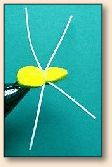
"Wait!" I want to yell, "It's not your turn! What fly pattern?" But the
next fisherman starts a tale of woe, filled with wasted hours and empty
creels, all of which sounds too familiar. He's just using the wrong bait,
declares Mr. Caughtfish and I see the waitress approaching. Desperately
I wave her off and, as she shrugs and looks to the sky for help that's
not coming, and behind me the mystery fly is revealed. I hear the
secret in a nervous dither that turns to disbelief. No, it's not possible,
I think. Stunned, I take a big drink of tepid water but, yes, it is true.
In the two square feet of shelf space that is Wal-Mart's entire inventory
of fly fishing equipment, Mr. Caughtfish found a sponge spider. He
bought two, yellow with whiterubber legs, but one is so beaten up he's
going back to get another. Figures it was about the best buck and a
quarter he's ever spent.
The bits of orange pulp in my juice has gathered to the top and
my gravy breakfast congealed to something resembling food
served in the military. I signal for the check and leave a healthy
tip, as if it would explain my insanity. Later, after hours of tying,
I still have not produced a spider I am willing to show in public.
And so I go to Wal-Mart, where, between dingy fly lines and
aged plastic fly boxes, I find a small rack of yellow sponge spiders.
I buy one and spend the next hours recreating it. And the more I
tie the more I am confused. Panfish, particularly bluegill, have well
recognized diets. Aquatic insects, insect larvae and crustaceans are
their primary prey. Vegetation, fish eggs, small fish, mollusks, and
snails and the occasional beetle or ant fill out the menu. Notice that
the list does not include specific reference to spiders. Why?
Terrestrial spiders and water are not a common pair. True, there
are water spiders that inhabit certain lakes and ponds, but, the real
question is "just how often does a bluegill see a floating spider?"
The answer is probably "never" unless a spider is blown out of a
tree and has the misfortune to land in the immediate vicinity of a
bluegill.
Then why is a sponge spider fly successful? The answer is: because
it doesn't look anything like a spider.
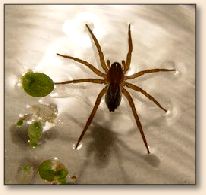
Consider the silhouette a real spider presents. First, a spider
has eight legs which splay around two oblong (sometimes tapered
but not pointed) shapes: (1) the abdomen or belly (also called the
opisthosoma) contains the heart, organs, and silk glands and (2) the
cephalothorax , the fused head and thorax (also called the prosoma)
contains the brain, jaws, eyes, stomach, and leg attachments. Do bluegill
count legs? Probably not, which would explain why spider imitations have
4 or 6 legs. Also, a spider's legs are quite long in relation to the torso and
have seven segments (of which we usually only notice three). Then why
do many sponge spider flies have short straight stubby rubber legs? Dunno.
Next, a spider has several pairs of tiny eyes located on top of the
cephalothorax. Creators of spider flies with a single pair of large
eyes on the sides of the thorax must know something I don't. Finally,
a spider has pedipalps which are feelers attached to the front of the
thorax that look like stubby legs, which we can only assume the
hook eye is supposed to represent, or at this point does it matter?
Terrestrial spiders that have the bad luck to be on the water have
a remarkable ability to walk on the surface film. They disturb very
little of the surface as they skitter back to something solid. Under
the best of circumstances, this is a very difficult action to accomplish
with anything heavier than a stiffly hackled dry fly, and certainly not
with sponge.
Note that soft hackles or other wet flies called "spider patterns" are
intended to represent the water spider (an aquatic species), and certainly
would appear to do so with more accuracy than floating varieties.
Which brings us back to the success of the sponge spider. Luck has as much
— often more— to do with catching fish as logic. What the facts
suggest is that a novice fisherman buying a sponge spider has the good luck
to purchase a generic insect fly, that represents nothing in particular, and
particularly not a spider. The sponge spider may look like a wasp, or bee,
or caterpillar, or beetle, or maybe like nothing in nature at all. Bluegill
probably don't consider that something that only sort of looks like
something to eat might be something else. It is the same inexplicable
attraction that makes spinnerbaits or stimulator flies work. Inexplicable,
as in can't be explained.
What we can presume to know is that luck is involved, and such
luck has to include something approaching the right size and color.
Even a carelessly delivered and retrieved fly that presents a tempting
profile can catch fish. Consequently, you would think that if the sponge
spider fly will work, so should any other reasonable insect imitation in
your fly box. Not so. The spider is so generic it defies bluegill senses
to determine if is something they don't want to eat. And, given the
choice, bluegill will chose to eat it.
GENERIC SPIDER PATTERN
Hook: standard dry fly hook #8-14.
Thread: Flat waxed nylon (same color as the foam)
Body (abdomen and thorax): sheet (fun) foam.
Legs: round rubber.
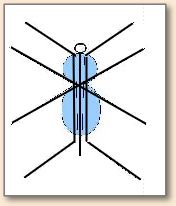
1. Lay a layer of thread along the entire hook shank. This
serves to help gluing and to color the shank to match the fly.
2. (Optional for 8 legged version) Lay two round rubber legs
along the hook shank with about ½ in. extending past both the
hook eye and over the bend. Use a figure 8 pattern to tie
down the legs and give them a "V" shape.
3. Gently wrap over the shank the shank is completely covered
with thread making a smooth finish of thread.
4. Bring the thread to ¼ distance down the shank from
the hook eye.
5. Cut a small strip of fun foam (about 3/8") shaped like
a .22 long rifle bullet .
6. Put a light coating of Super Glue on the thread covered shank.
7. Lay the foam on the hook shank with the end of the
taper just past the bend.
8. Tie down the foam letting it bend slightly around the
hook shank. (You have now segmented the foam and
the tapered end will be the spider's abdomen.)
9. Take the thread straight under the foam to the eye of
the hook and tie down the foam at that point, making a
round shape between the first tie down and the eye of
the hook.
10. Trim off excess foam.
11. Move the thread (again under the foam) back to the
first tie-down location and using "X" technique tie in a leg
on either side of the foam.
12. Move the thread (under the foam) back to the eye
and whip finish and coat with Hard As Nails.
GENERIC WATER SPIDER PATTERN
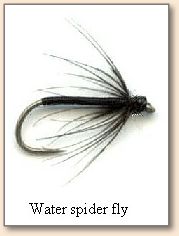
Hook: 2X nymph hook #12-16.
Thread: Flat waxed nylon (black or brown).
Bead: colored to match thread
Legs: soft hackle to match thread
1. Put the bead on the hook and work to the eye.
2. Wrap the hook shank with thread in 3-4 layers
until a smooth thread body has been created.
3. Tie in a soft hackle and wrap 3 times.
4. Whip finish behind bead. ~ Bob
About Bob:
Robert Lamar Boese has fly fished for five decades. He is an
environmental negotiator, attorney and educator who has provided
environmental legal services for more than thirty-three years including
active duty with the U.S. Coast Guard and Department of Justice. He is a
well known fly tyer with several unique patterns to his credit. He has
developed and authored federal and state regulatory programs
encompassing a broad spectrum of environmental disciplines, has
litigated environmental matters at all levels of the federal and state
court systems, and is a qualified expert for testimony in environmental
law. He has authored over 60 published text chapters, comments or
articles on environmental matters, is a member of the Colorado, District
of Columbia and Louisiana Bar Associations, and is a certified mediator.
In addition to his legal practice, Mr. Boese has been a high school
teacher, an associate professor of Environmental Law and Public Health,
has authored numerous fiction and sports publications, and is a softball
coach and nationally certified volleyball referee. He is the president
of the Acadiana Fly Rodders in Lafayette, Louisiana and editor of
Acadiana on the Fly. He has been married for thirty years and is the
father of two fly fishing girls (25 and 21). For additional information
contact: Boese Environmental Law, 103 Riviera Court, Broussard, LA 70518
or call 337.856.7890 or email coachbob@ymail.com.
|
